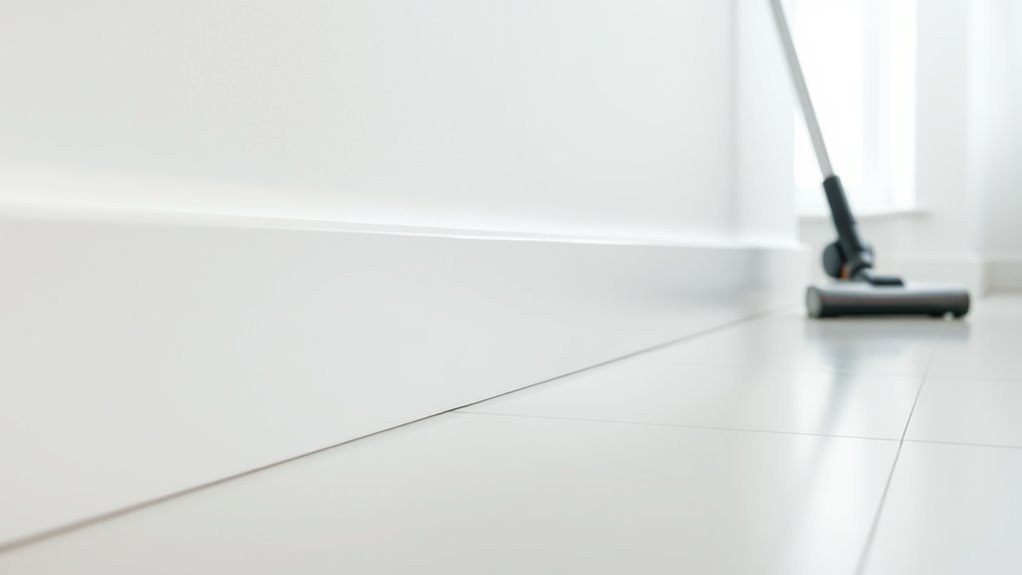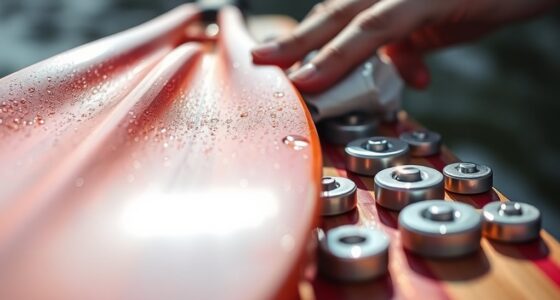To say goodbye to dust lines along your baseboards, gather microfiber cloths, gentle cleaners, and a vacuum with a brush attachment. Dust thoroughly, then lightly dampen the cloth to wipe along corners and edges. For stubborn spots, use a soft toothbrush, then dry the surface completely with a clean towel. Maintaining routine cleaning and proper humidity levels helps prevent dust buildup. Keep going to discover more effective tricks for a spotless finish.
Key Takeaways
- Use a vacuum with a brush attachment to remove dust before wiping for thorough cleaning.
- Dust baseboards weekly with microfiber cloths or dusting brushes to prevent buildup.
- Spray cleaning solutions onto cloths, not directly on baseboards, to avoid streaks and residue.
- Follow proper angles and reach techniques, especially in corners and edges, for effective dust removal.
- Maintain indoor humidity below 50% to reduce dust adhesion and prevent mold growth on baseboards.
Gather Your Supplies
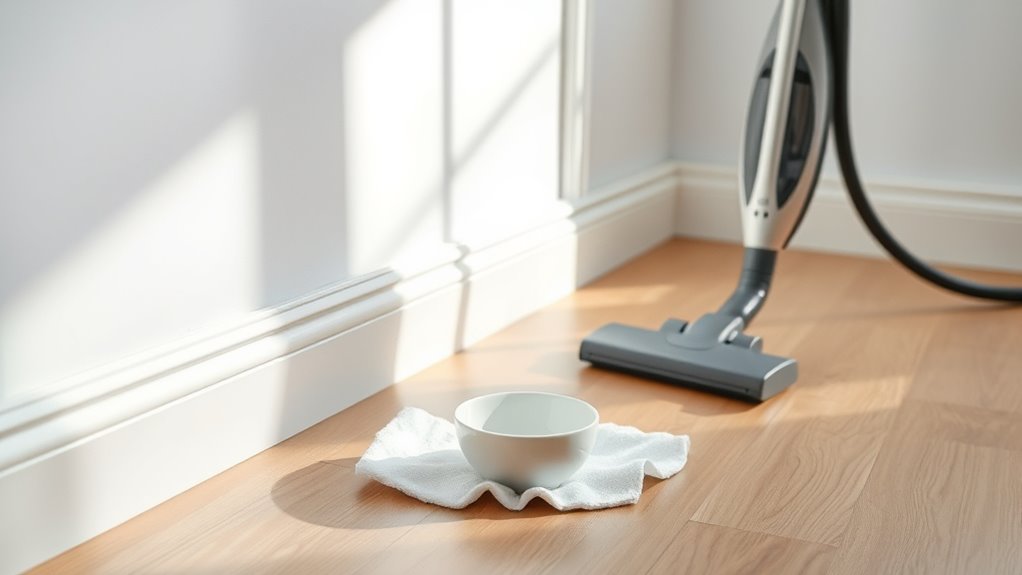
Before you begin cleaning the dust lines along your baseboards, you need to gather the right supplies. Start with clean, microfiber cleaning cloths—they’re gentle and effective at trapping dust without scratching surfaces. Next, grab some cleaning sprays designed for your type of baseboard material; these help loosen stubborn dirt and make wiping easier. Avoid harsh chemicals unless necessary, opting for gentle, multi-surface cleaners when possible. Have a small spray bottle nearby for quick application. If you prefer, you can also use a damp cloth with water for light dusting. Keep everything within arm’s reach to streamline the process. Using the right cleaning tools can make a significant difference in achieving a thorough clean. With these supplies ready, you’ll be well-prepared to tackle those dust lines efficiently and leave your baseboards looking fresh.
Dust the Baseboards Carefully
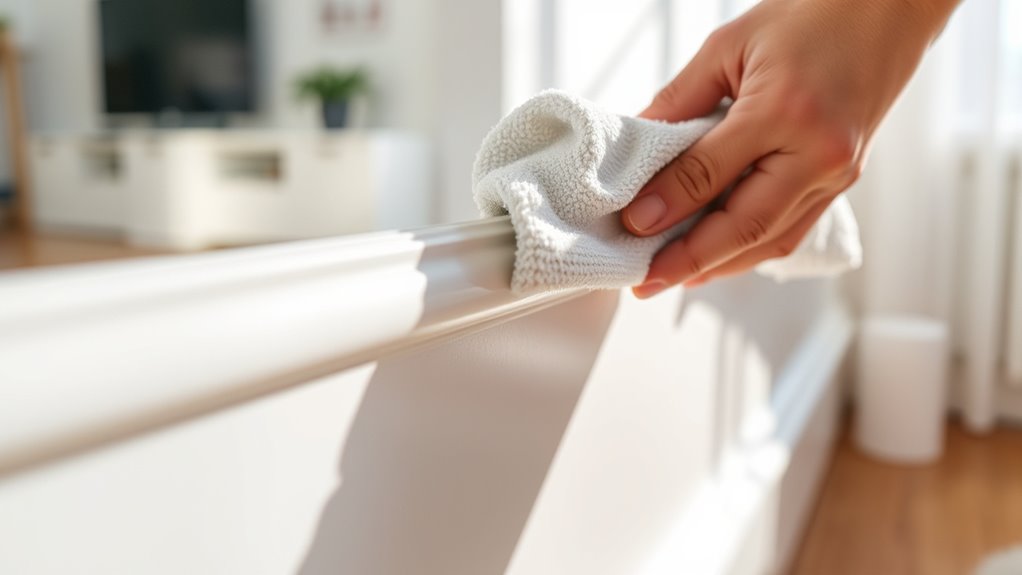
To dust your baseboards effectively, pick the right tool, like a microfiber cloth or a dusting brush, to trap dirt without scratching the surface. Use the correct angle and reach to reach every corner without straining, ensuring thorough cleaning. Stick to a regular dusting schedule to keep buildup from becoming a problem. Incorporating vertical storage solutions can help maintain an organized space that makes cleaning easier and more efficient.
Use the Right Tool
Using the right tool is essential for cleaning your baseboards without causing damage. An electric vacuum with a brush attachment works great for quickly removing loose dust and debris without scratching the surface. It’s efficient and prevents dust from settling back or spreading around. For more thorough cleaning, a microfiber cloth is ideal. Its soft fibers trap dust effectively and won’t scratch or streak the baseboards. Before wiping, lightly dampen the cloth to pick up stubborn grime. Avoid using rough scrubbers or paper towels that can leave scratches or streaks. By choosing the right tools, you’ll make the job easier and guarantee your baseboards stay looking fresh and clean without any damage. Incorporating automation tools can also streamline your cleaning routine, making maintenance even simpler.
Angle and Reach Technique
Holding the cleaning tool at the right angle is crucial for effectively dusting your baseboards. This technique ensures dust is lifted without spreading debris or missing spots. Use a gentle, sweeping motion, adjusting your reach to cover every inch. A proper angle allows your dusting tools to glide smoothly, picking up dust efficiently. For added comfort and accuracy, consider using a microfiber cloth or a duster with an extendable handle. Being mindful of your angle and reach technique can make all the difference in achieving a spotless surface.
Regular Dusting Schedule
Incorporating a regular dusting schedule guarantees your baseboards stay clean and free of buildup. Consistent cleaning frequency prevents dust accumulation from becoming stubborn or hidden behind layers of grime. Aim to dust your baseboards at least once a week to maintain a tidy appearance and improve air quality. Skipping regular dusting allows dust and dirt to settle deeply, making future cleaning more difficult. Use a microfiber cloth or a slightly damp sponge, following the angle and reach technique to remove dust effectively. By sticking to this routine, you’ll minimize dust lines and prevent the need for intensive scrubbing. A reliable schedule keeps dust from accumulating excessively and ensures your baseboards look fresh and well-maintained. Regular dusting also supports indoor air quality, creating a healthier environment for everyone in your home.
Use a Slightly Damp Cloth
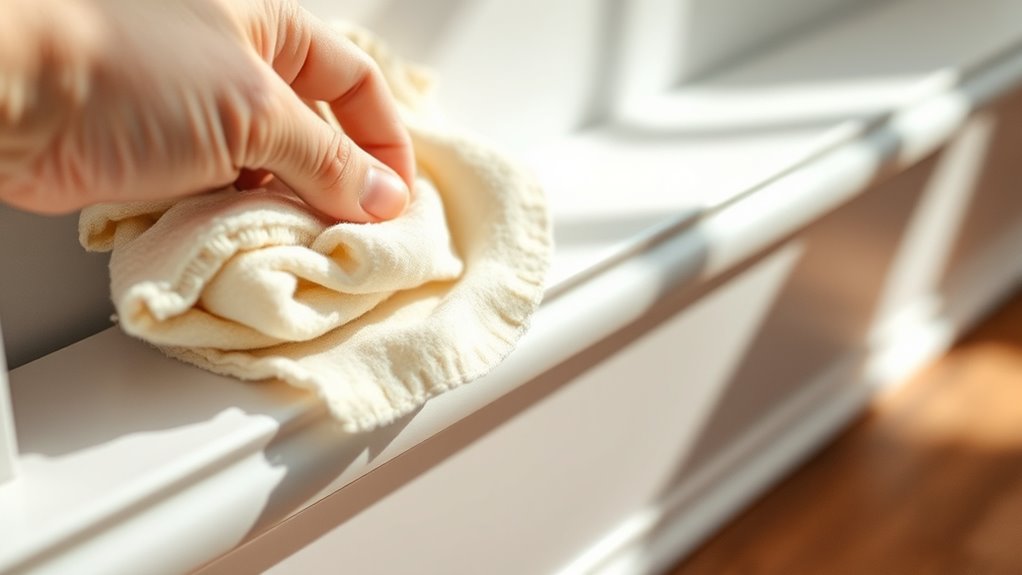
A slightly damp cloth is your best tool for cleaning dust lines along baseboards without causing damage. The right cloth moisture guarantees dust is lifted effectively without turning your baseboards into a mess. Too much water can leave streaks or damage paint, so wring out the cloth thoroughly before use. Incorporate a gentle, consistent cleaning frequency—once a week or as needed—to prevent dust buildup. Using a damp cloth allows you to pick up dust particles more efficiently than a dry cloth, reducing the need for aggressive scrubbing. Keep in mind that regular, careful wiping prevents dust lines from forming and keeps your baseboards looking neat and fresh. Employing automated insights can help you identify the most effective cleaning schedules based on your home’s dust accumulation patterns. This simple step makes a big difference in maintaining a dust-free home environment.
Tackle Stubborn Dust With a Toothbrush
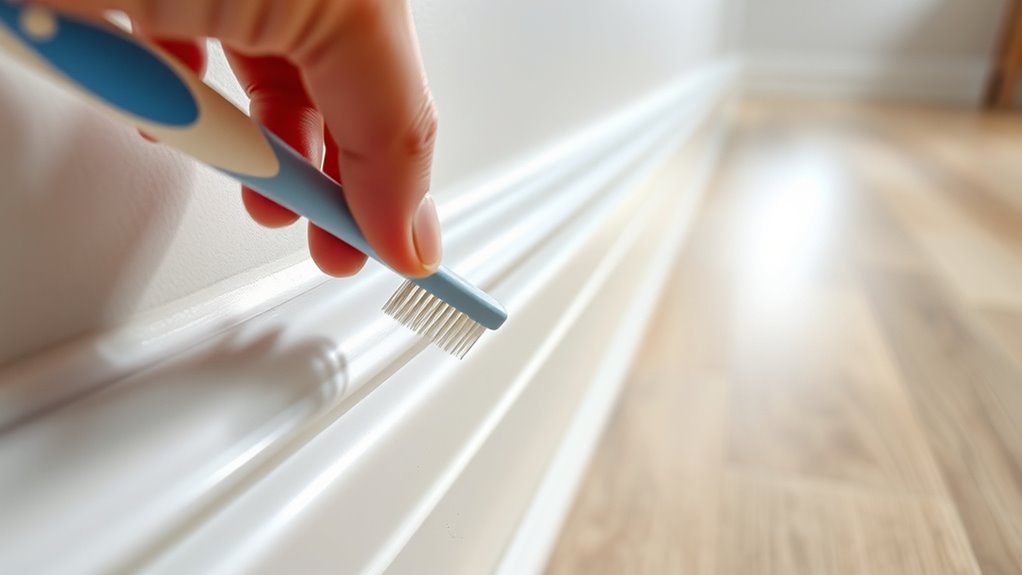
When dust has settled into crevices or stubborn spots along your baseboards, a toothbrush becomes an invaluable tool. Its small bristles can reach tight corners and remove dust that a cloth misses. Think of it as an extension of your dental hygiene routine—meticulous, effective, and thorough. Plus, it’s perfect for tackling those tricky spots in your home, much like applying gardening tips to keep your plants healthy. Using the right payment processing tools can also help streamline your cleaning routine, ensuring efficiency in all aspects of home maintenance.
Here are four tips to maximize your toothbrush cleaning:
- Use a soft-bristled toothbrush to avoid damaging paint.
- Dip it in a mixture of soap and water for better dust removal.
- Focus on corners and edges for complete coverage.
- Rinse and dry the toothbrush afterward for future use.
Dry the Baseboards Thoroughly
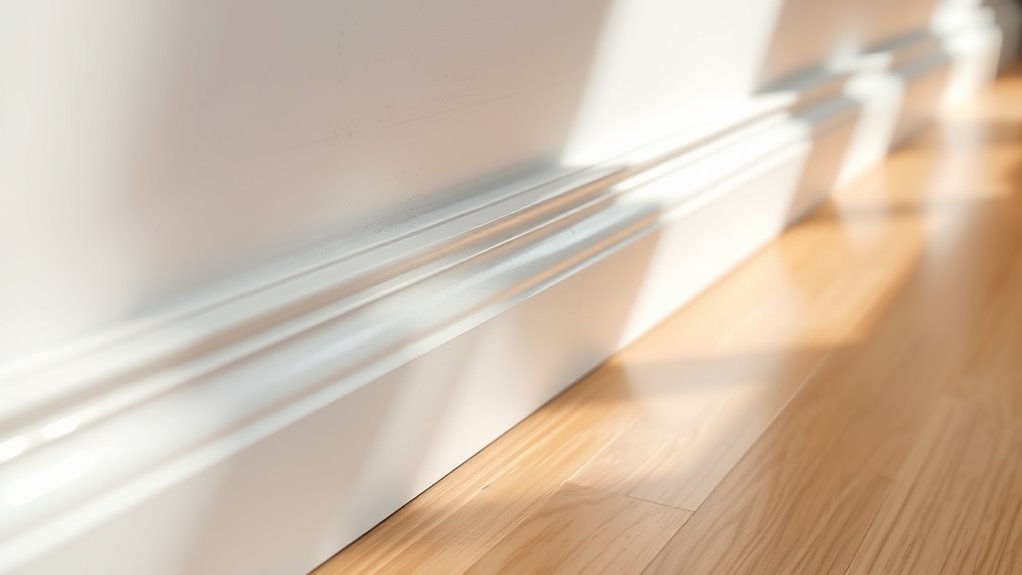
After cleaning, make sure you dry your baseboards completely with a clean towel. Air drying is best, so avoid humid environments that can slow the process. Ensuring they’re dry helps prevent future dust buildup and water damage. Incorporating proper drying techniques can further safeguard your home’s surfaces.
Use a Clean Towel
Once you’ve wiped down the baseboards, it’s crucial to dry them thoroughly to prevent streaks and water spots. Using a clean towel ensures no dirt or residue is left behind, which helps with dust prevention. A fresh, dry towel absorbs moisture quickly, leaving your baseboards spotless and dry.
Here are four tips to maximize effectiveness:
- Use a soft, microfiber cleaning cloth to avoid scratching.
- Gently pat and wipe to remove excess water.
- Switch to a dry section of the towel frequently.
- Run your towel along the baseboards for a streak-free finish.
Air Dry Completely
To guarantee your baseboards stay spotless and free of water spots, it’s essential to let them air dry completely. After wiping or cleaning, avoid rushing the process by using towels again. Instead, ensure proper ventilation in the room to promote faster air drying. Open windows or turn on a fan to increase airflow, which helps moisture evaporate more efficiently. Allow ample time for the baseboards to dry thoroughly before touching or decorating them further. This step prevents water spots or streaks that can attract dust and create those unsightly dust lines. Patience is key—air drying with good ventilation guarantees a clean, dry surface, setting the stage for a dust-free, polished look along your baseboards. Additionally, understanding the benefits of proper skincare like eye patches can help you feel more refreshed and prepared to tackle home cleaning tasks with energy and focus.
Avoid Humid Environments
Humid environments can hinder your efforts to keep baseboards dry and dust-free. Excess moisture encourages mold growth and makes dust cling more easily. To prevent this, focus on humidity control and guarantee thorough drying. Here are four tips to help you avoid humid settings:
- Use dehumidifiers in damp areas.
- Improve ventilation with fans or open windows.
- Fix leaks promptly to reduce moisture sources.
- Keep indoor humidity below 50% to prevent mold and maintain dry baseboards.
- Regularly monitor your home’s humid environment to ensure optimal dryness and dust control.
Regular Maintenance Tips
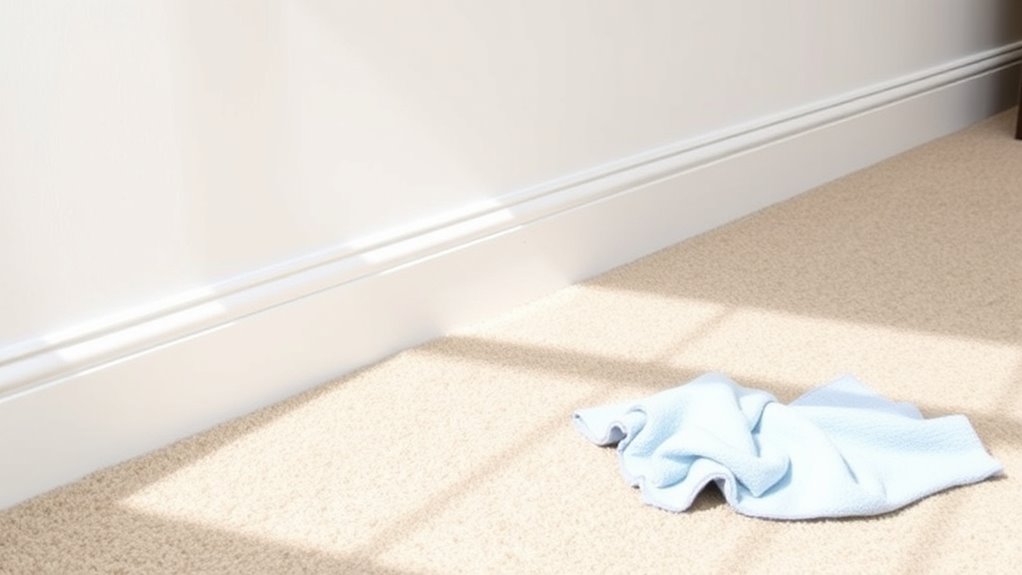
Regular maintenance is essential for keeping dust lines along baseboards at bay. To do this effectively, use a vacuum attachment with a brush or crevice tool to remove dust and dirt regularly. Aim for a cleaning frequency that prevents buildup—at least once a week is ideal, especially in high-traffic or dusty areas. When you vacuum, focus on the edges where dust tends to settle, ensuring you don’t miss these spots. Keeping a consistent schedule prevents dust from accumulating over time and reduces the need for intensive deep cleaning. Additionally, wiping down the baseboards with a damp cloth after vacuuming can help remove any stubborn dust. Staying on top of these simple maintenance tasks keeps your baseboards looking fresh and dust-free.
Additional Tricks for a Spotless Finish
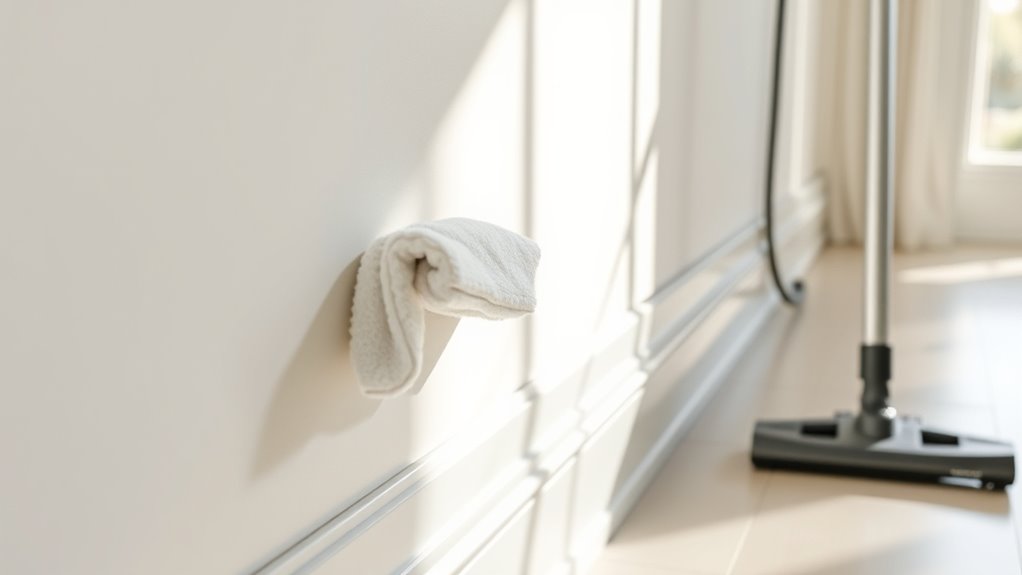
After maintaining your baseboards regularly, you can take additional steps to achieve a truly spotless finish. Start by spraying a cleaning spray onto a microfiber cloth rather than directly on the baseboards. This prevents excess moisture and streaks. Then, wipe along the baseboards carefully, paying attention to corners and crevices. For stubborn dust or dirt, reapply the spray and use the microfiber cloth to lift debris effectively. To enhance the shine, buff the baseboards with a dry microfiber cloth after cleaning. Finally, consider using a soft brush or vacuum attachment for hard-to-reach areas before wiping. These simple tricks ensure your baseboards stay spotless, dust-free, and looking fresh longer.
Frequently Asked Questions
How Often Should I Clean My Baseboards to Prevent Dust Buildup?
You should clean your baseboards at least once every two months to prevent dust accumulation. Regular cleaning maintains a tidy appearance and reduces the need for more intensive scrubbing later. If you have pets or allergies, consider cleaning more frequently, like once a month. Consistent cleaning frequency keeps dust at bay, making your home healthier and easier to maintain. Don’t wait too long—staying proactive saves you time and effort.
Can I Use Natural Cleaning Products Instead of Commercial Ones?
You might think commercial cleaners are your only option, but eco-friendly cleaning with natural ingredients works just as well. Using natural ingredients like vinegar, baking soda, or lemon not only cleans effectively but also protects your home and environment. You can customize your cleaning solutions, avoiding harsh chemicals. So yes, you can definitely use natural ingredients instead of commercial ones, making your cleaning routine safer and more sustainable.
Are There Specific Tools for Cleaning Baseboard Corners Effectively?
You can effectively clean baseboard corners using specific tools like electric scrubbers, which make reaching tight spots easier, and microfiber cloths that trap dust without spreading it. Electric scrubbers help loosen grime in corners, saving you time and effort. Microfiber cloths are gentle yet thorough, ensuring you remove dust and dirt completely. Combining these tools gives you a quick, efficient way to keep your baseboard corners spotless.
How Do I Remove Scuff Marks From Painted Baseboards?
To remove scuff marks from painted baseboards, start with a gentle cleaner or a mixture of water and mild dish soap. Use a soft cloth or sponge to lightly scrub the marks, being careful not to damage the paint. For stubborn scuffs, consider applying some baseboard polishing or perform a quick paint touch-up if the marks leave scratches. This keeps your baseboards looking fresh and well-maintained.
What’S the Best Way to Clean Baseboards in High-Traffic Areas?
Imagine your baseboards as the silent guardians of cleanliness. In high-traffic areas, you should clean them weekly to prevent buildup, especially if they’re painted or wood. Use a damp microfiber cloth for regular dusting, and a gentle cleaner for stubborn dirt. Adjust your cleaning frequency based on foot traffic, ensuring your baseboards stay pristine and protected—keeping your home fresh and inviting with every sweep.
Conclusion
By following these simple steps, you’ll keep your baseboards spotless and dust-free. Regular maintenance prevents dust buildup from sneaking back in, so stay consistent. Remember, a little effort goes a long way—don’t let dust settle in and become a bigger problem later on. Keeping up with these tricks now saves you time and effort down the road. With a little care, your home will always look its best, shining like new.

